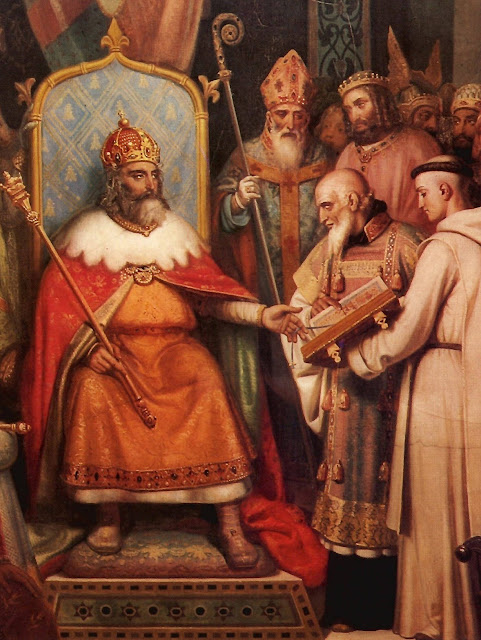(Tokugawa Ieyasu, painted by Kanō Tan'yū (1602–1674), [Public Domain]
via Creative Commons)
Near the end of the Sengoku
Period (The Warring States Period) lasting from the mid-15th century to the
mid-16th century CE, three successive warlords unified the warring daimyo lords
of Japan under the authority of a single, powerful shogun—the supreme military
leader of Japan that was generally supported by the Japanese Emperor. The first
of the three unifiers was Oda Nobunaga. He brought around half of Japan under
his control, and the stability he brought officially ended the Sengoku Period.
Nevertheless, war did not end. He died in 1582 CE after his vassal, Aketchi
Mitsuhide, betrayed him and rebelled. After Nobunaga’s death, power shifted to
a brilliant peasant soldier named Toyotomi Hideyoshi, who was promoted to the
rank of samurai. He avenged Nobunaga’s death by defeating Mitsuhide, and he
expanded Nobunaga’s conquered territory to include all of Japan. Hideyoshi even
tried to invade Korea several times, but died in 1598, shortly after the
expeditions failed. With the death of Hideyoshi, Japan broke apart, once more,
and a warlord named Tokugawa Ieyasu took command of one of the leading
factions. In 1600, Ieyasu won the Battle of Sekigahara, making him shogun and
cementing the unification of Japan. Nobunaga, Hideyoshi and Ieyasu, however,
did much more than attain power—they also made themselves into gods.
Oda Nobunaga wanted to be
seen as more than just a powerful daimyo. He labeled himself ‘tenka’ (the
realm), and his vassals would address him as such. Nobunaga expanded his
importance out of mundane conceptions of governments and titles into the spiritual
realm. Oda Nobunaga encouraged the belief that being loyal and respectful to
his rule would lead to good health and fortune in this life and the next.
After Nobunaga’s death,
Toyotomi Hideyoshi worked hard to cultivate his own spiritual importance in
Japan. First, the victorious Hideyoshi went to great lengths to make himself an
equal of the Japanese emperor. He would have the emperor come visit him at his
own palace, rather than journeying to the emperor’s own home in Kyoto.
Hideyoshi also had his family members (his consort and his son) recognized as
equal in status to the family of the emperor. Yet, like Nobunaga, Hideyoshi
wanted to be more than a mere symbol of government—he wanted to be a divinity.
Therefore, he put in place a plan that would bring about his deification after death.
Once he died, he wanted to be known as the Great August Deity, and there would
be a national network of shrines for his worship.
When Hideyoshi died, however,
he had no mature, legitimate heirs, causing Japan to break apart into more war.
When Tokugawa Ieyasu brought the other daimyo back into submission, he
underwent steps to bring about his own godhood—and demolished Toyotomi
Hideyoshi’s shrines in the process. As Ieyasu neared death, he prepared for his
own deification. He wrote in his will that he wanted to be enshrined in an
impressive memorial located at Nikkō. Like Hideoyshi, Ieyasu also prepared a
divine name for himself—his impressive title was, “Great Incarnation, Shining
Over the East.” The shrine at Nikkō remains one of the great tourist locations
of Japan.
Source:
-
A
Modern History of Japan: From Tokugawa Times to the Present (Third Edition), by
Andrew Gordon. New York: Oxford University Press, 2014.











